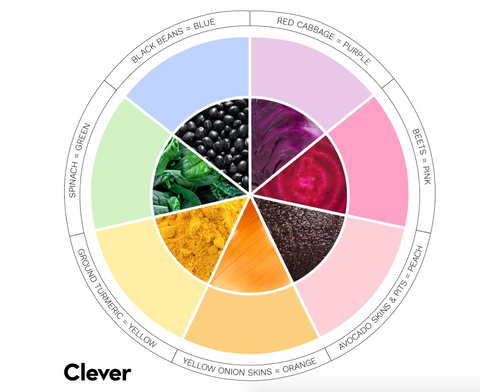
Natural Tie Dye: How To Tie Dye Sustainably
The art of tie dying is intrinsically sustainable. It encourages people to reuse and up-cycle old articles of clothing to create a new masterpiece that’s full of vibrant creativity. And with natural and eco-friendly tie dye, it can be even better for the environment.
At MADI Apparel, we love sustainable fashion — but we also love making a statement. We work with natural dye artists in our local community to create fashion-forward colors and designs that feature flowers and plants from our area and make our bamboo fabrics a real statement piece in any wardrobe.
Do you have an old MADI t-shirt you want to up-cycle? Or maybe a pile of worn-out socks that could use a little refresh? Before you run to the store and grab synthetic dyes and cheap cotton clothing, check out this helpful guide for how to tie dye sustainably.
History of tie dye
Most people think that tie dye started in the 1960s, when Woodstock first started and Abbey Road was released by The Beatles. But the truth is, the colorful history of tie dye can be linked back to ancient Asia, during the T’ang Dynasty between 618 and 906 C.E. This was before synthetic dyes were released, and Asians made their own natural tie dye using things like:
In America, the rise of popularity in tie dye started actually around the 1920s as a means of creating low-cost home decor items using cotton and flour sacks. And then in the ‘60s, it came back to life with the hippie movement because of its bright colors and unique designs.
Today, tie dye is back in style and can be seen in a variety of clothing options, from tie dyed sweatsuits to socks and handbags. In fact, we think everything is better tie dyed.
How to tie dye sustainably
Tie dye is very on trend right now. But unfortunately, bad dying practices can be extremely harmful for the environment. For example, in 2011, Greenpeace released photos of rivers in China and India that were turned magenta and green from clothing dye that seeped into the water supply from textile factories. Here's a full CNN article about how colorful clothes are killing our environment.
Today, more and more companies are starting to realize that dying fabric can actually be really harmful to the environment and the textiles we wear. With huge innovations in the $7 billion textile dyes market, we are starting to see a shift in the way colors and clothing are produced.
At MADI Apparel, the goal of sustainability is woven into the very fabric of our being. Not only are our fabrics made from the highest-quality sustainable materials available today, we also practice very sustainable and eco-friendly tie dying practices that keep our cities and our practices as clean as possible.
So when you want to stay on trend this summer with a new tie dye set, we recommend these tips for how to tie dye sustainably.
Click here for our behind the scenes of how to dye using avocado pits and skins. We contracted natural dye artist Alyx Jacobs to create a blush collection for us, hand dyed from avocados.
Click here for our dye artist's tutorial of how to dye using natural indigo.
Make your own natural tie dye
The textile industry is the second most polluting industry in the world, with synthetic dyes being linked to nearly 20% of all global water pollution.
Using natural tie dye can be a great way to combat this global problem, while also using up old fruits and veggies you have laying around the house.
Plants and flowers can be combined and played with to create a truly one-of-a-kind natural tie dye that is as beautiful as it is sustainable. For example, avocado pits, when soaked in water, will turn clothes into a lovely pink color. Utilizing bright yellow marigolds can create a lovely golden hue, like our Marigold collection! Reusing natural materials like plants is a sure-fire way to practice eco-friendly tie dying.
Here are a few of our favorites from Clever:

Here are some examples of Hand-Dyed Natural Dye Collections by MADI Apparel:
 2019 Seasonal Rosy Blush Collectionhand-dyed from avocado pits and skins |
 Our 2018 Seasonal Indigo Collectionhand-dyed from indigo flowers |
|
Use sustainable clothing
Clothes that are made from sustainable or biodegradable fabrics will actually hold the natural tie dye better than synthetic fabrics and create a much bolder, more saturated color. Using fabrics like our natural bamboo basics is a great choice for a fully eco-friendly approach to dying clothes.
Dying sustainable fabrics also creates a softer look, which can be a great alternative to the bold and over-the-top look of traditional tie dye.
Plus, this is a great way to celebrate Plastic-Free July!
Work in small batches
Don’t waste water! Water is a finite resource on our planet and some cities and states are in expensive droughts that take a toll on the environment and many’s wallets. Not to mention the fact that the cotton shirt you’re considering dying may have already consumed tons of water to manufacture (one pound of cotton requires 700 gallons of water to create).
You need to preserve water as much as possible. Although water is necessary to the tie dying process, it can be limited and rationed in a way that makes for a more sustainable process.

^ Alyx Jacobs hand dying a small batch indigo collection for MADI Apparel in 2018. Photo is by Tara Shupe Photography
Working in small batches will allow you to use less water during the natural dying process, while still ensuring a beautiful final product. Simply soak the fabric in the natural tie dye longer, possibly between 12 to 24 hours, to allow the product to bond more easily and create the color you’re hoping for.

Join our tie dye workshop!
Want to get your hands dirty? Join us for our tie dye workshop to see how our guest artist Alyx gets our products to be so beautiful. Coffee and mimosas will be served.

 2020 Seasonal Marigold Collection
2020 Seasonal Marigold Collection